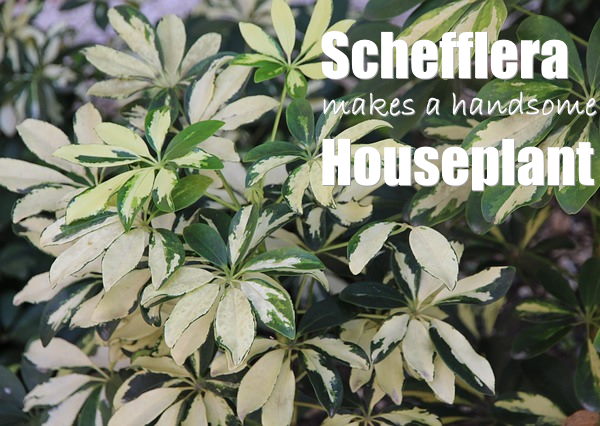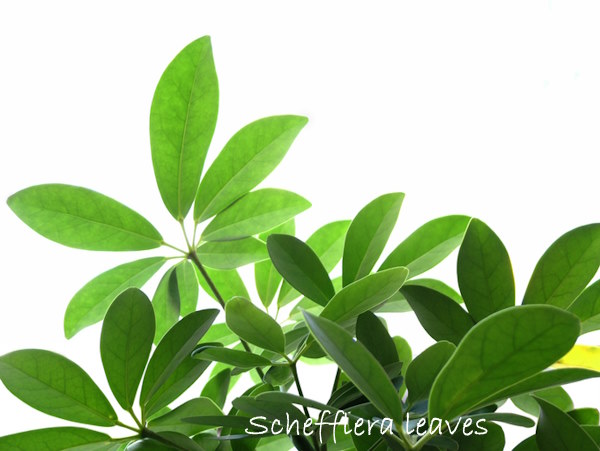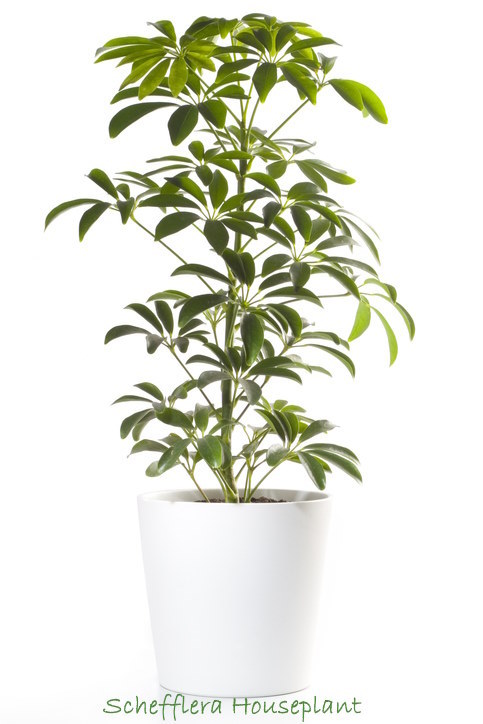Care for Schefflera Plant
Care for Schefflera plant indoors is a breeze. And you'll love how it instantly lends a lush, tropical feel to your home.
Schefflera has been a common house plant a long time, and it's easy to see why. It makes a beautiful accent for any brightly lit room. In this guide, you'll discover how much water it wants, when to repot, and what to do about dropped leaves.

Get to Know Your Schefflera Houseplant
Its upright branching stems bear horizontal spoke-like leaves that consist of about 8 large, dark-green leaflets. It also goes by the common name Umbrella Tree.
This handsome houseplant has origins in Australia and the Pacific Islands.
How big does it get? You can expect your houseplant to grow to 6 ft (1.8 m). Tall Schefflera plants will need support. Mature plants have aerial roots that can be trained to cling to a moss stick.
Is Schefflera toxic to cats and dogs? Yes. According to the ASPCA, it contains calcium oxalate crystals that is poisonous to pets. Contact your veterinarian immediately if you believe your pet has ingested this plant.
Schefflera Varieties
A dwarf variety exists -- Schefflera arboricola is a much smaller and bushier plant, eventually growing to 4 ft (1.2 m) tall.
Newer hybrids have given us some exciting named varieties to choose from. Schefflera arboricola 'Variegata' is a variegated form with green and cream leaves. 'Gold Capella' is boldly splashed with golden yellow. 'Luseane' has smaller leaves than the species, sometimes available with variegated leaves.
Schefflera Plant Buying Tips
Buying a new Schefflera? Choose a plant based on the size and type you want. They're all easy to grow. With good care, this beautiful, tropical house plant will live for many years.
 Image credit vasiliki / istockphoto
Image credit vasiliki / istockphotoCaring for Schefflera Year-Round
Care for Schefflera plant is easy. Put it in a bright spot, out of direct sun and place the container on a saucer of wet pebbles to increase the humidity around it.
Pruning schefflera may be necessary on large plants. As the plant ages, it loses its lower leaves, becoming leggy. Prune it back harshly to stimulate new growth and to keep it full. Pinching off the growing tips will promote branching.
Dropped leaves? Schefflera doesn't like to be moved around and may drop its leaves if exposed to cold drafts or blasts of hot air from heating vents. Also, overwatering can cause the lowest leaves to fall off.
Keep leaves clean by gently wiping them with a soft, damp cloth. Built-up dust interferes with photosynthesis so it's a good idea to wipe leaves every couple weeks to keep your plant healthy. My Schefflera had leafshine product sprayed on its leaves when I bought it, but it's not necessary. Those pinwheel leaves are naturally glossy.
Repot in spring when roots grow through the drainage holes in the bottom of the pot. Use a heavy pot to prevent toppling -- this plant can get top-heavy.
Pests are few, however spider mites may invade if the air is dry. Keep an eye out for webbing between stems and the undersides of leaves. Raising the humidity around the plant in winter will help to prevent an invasion. Another pest to watch for is scale; these small, brown disk-like pests may be found under the leaves or along the stems. Treat any infestation immediately.
 Image: vspn24 / istockphoto
Image: vspn24 / istockphotoHow to Care for Schefflera Plant Indoors
Light: Bright light, no direct sun. Turn plant occasionally in front of the window to encourage even growth. Variegated types of Schefflera that fade aren't getting enough light. Leggy stems with long spaces between leaves are another symptom of too little light. Schefflera plant responds well to fluorescent light.
Water: Water thoroughly to get all the roots wet. Allow the top inch of soil to dry out between waterings. Yellow leaves are a sign of overwatering. Drooping leaves usually indicate that the soil is too dry.
Humidity: Average or higher indoor (about 40-50% relative humidity). If your home gets too dry in the winter, use a cool-mist room humidifier or mist with water.
Temperature: Average to warm room temperatures (65-80°F/18-27°C). This tropical native doesn't like either hot or cold drafts -- and may protest by shedding its leaves. Keep Schefflera away from cold windows and doors in the winter, as well as blasts from AC or heat vents.
Soil: Good-quality houseplant potting mix.
Fertilizer: Feed monthly with a water-soluble houseplant fertilizer that includes micronutrients. New leaves that seem wilted and pale may be suffering from lack of fertilizer.
Propagation: Take stem tip cuttings in spring and summer.


